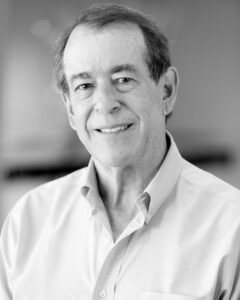November 1, 2021
November 2021: Loren Kieve

Loren Kieve (he/him)
Member, ACS Bay Area Lawyer Chapter Board of Advisors
As a founding member of the San Francisco Bay Area Lawyer Chapter, it has been my privilege to support the ACS in its great work, first under Caroline Frederickson (whose father, the esteemed late Professor George Frederickson, I knew from serving on a Stanford board with him), and now under Russ Feingold.
I have also been blessed to be able to spend a fair amount of my time over the last 27 years helping build the Institute of American Indian Arts (“IAIA”), literally from the ground up, and then expanding its footprint and reach to become the nation’s preeminent educational institution for Native Americans and Alaska Natives.
I suspect most of ACS’s readership has never heard of the IAIA, but it is a unique institution in Indian Country and our nation’s educational pantheon. The IAIA’s official name is the Institute of American Indian and Alaska Native Culture and Arts Development. In its latest iteration, it was chartered by Congress in 1987. Its roots go back to 1960 when it was founded as a groundbreaking high school for Native Americans to study art and the arts at the Santa Fe Indian School.
In 1994, President Clinton appointed (and the Senate confirmed) me as an IAIA trustee. I was practicing law in Washington, D.C. at the time, and I thought I had gone to heaven. As a Cherokee and an officer of the United States, I got to work with Native Americans, education and art – all passions of mine – in Santa Fe, New Mexico, where I had grown up. At that point, the IAIA was housed in leased, substandard space at the College of Santa Fe, including temporary WWII Quonset huts that should have been torn down long ago.
1994 was also the year of the 105th Congress. Under Newt Gingrich’s speakership, Congress started slashing the IAIA’s federal appropriation. Two years later, Congress reduced it to a third of what it had been stating that it would be the last year of federal funding. The IAIA president resigned and, unknown to the board, sent out letters saying that the Institute was going to close. Many of our students left.
I was then elected by my fellow trustees to chair the board. Most people said that we should close up shop, but I had another idea. We had a small $12 million endowment, and a local developer had given us 40 acres ten miles south of town, but there was nothing else there, not even a road. We would take half of the endowment and start building a new campus; reduce our curriculum to its bare bones; and use the remaining money to keep us going as a college.
On a cold winter New Mexico day, tribal elders planted seeds in a blessing ceremony, and we broke ground. I retained Manny Lujan (former Republican NM Congressman and Interior Secretary) to work the halls of Congress with me to turn the sentiment around. It worked. My fellow trustees have elected me to chair the board for most of the time since then. We have expanded our campus, our curriculum and our student enrollment.
We’ve gotten our federal appropriation back to where it was when I first joined the board and we’ve embarked on more projects since then, including expanding our curriculum and outreach and beginning construction on two new buildings this year.
In 2015, President Obama reappointed me to another term as a trustee. Since then, we’ve built the most effective board in the school’s history, recently with the addition of three members of President Obama’s Native American leadership, two of whom are now working for the Biden-Harris administration in senior roles.
The IAIA’s graduates and educators are among the leading artists, poets, innovators and public servants in the country. They include the current Poet Laureate of the United States, Joy Harjo; award-winning novelist and IAIA professor Tommy Orange; N. Scott Momaday, the first Native American Pulitzer Prize winner; nationally-recognized artists Fritz Scholder, Dan Namingha, Rose B. Simpson, Roxanne Swentzell, Tony Abeyta, Alan Hauser, T.C. Cannon and Char Teters, to name just a few; film-maker Chris Eyre; and tribal and government leaders such as George Rivera.
The IAIA is unique among higher learning institutions. It not only has associate, bachelor, bachelor-of-fine-arts and master-of-fine-arts programs in the arts, creative writing, performing arts, and museum studies, but its art museum, MoCNA is one of the very few university art museums to have been accredited by the American Alliance of Museums. In 2020, the Ford Foundation named it one of the country’s 20 Black, Indigenous and People of Color “Cultural Treasures.” MoCNA regularly curates cutting-edge exhibitions that are shared with other museums. Our impressive website (www.iaia.edu) doesn’t do justice to all that IAIA does. USA Today also named the museum the third best art museum in the country.
In 2012, for my work in the law and at IAIA, Stanford University inducted me into its Multicultural Alumni Hall of Fame. (Other inductees that day included Michelle Alexander.) In 2017, the University of New Mexico honored me with its Bernard S. Rodey Award (to an individual who has “devoted an unusual amount of time in a leadership capacity and whose efforts have contributed significantly to the field of education”).
In 2019, Stanford’s President asked me to serve on a seven-member committee to recommend a University policy on naming University buildings and features. He adopted our recommendations and the University has now renamed the buildings and features formerly named for Junipero Serra.
I continue to support and serve on the boards of other great organizations, but the IAIA has been my major “night job” and commitment for the past 27 years, and I hope to be able to continue that for as long as I am able and the then-President lets me do it.



